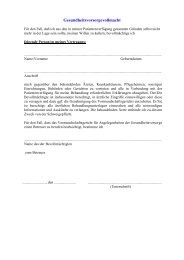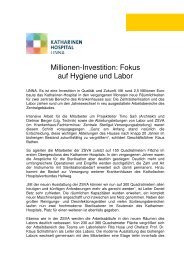Diagnostik der Osteomyelitis bei DFS
Diagnostik der Osteomyelitis bei DFS
Diagnostik der Osteomyelitis bei DFS
Sie wollen auch ein ePaper? Erhöhen Sie die Reichweite Ihrer Titel.
YUMPU macht aus Druck-PDFs automatisch weboptimierte ePaper, die Google liebt.
<strong>Osteomyelitis</strong> with soft tissue sinus<br />
tract<br />
Sagittal images show decreased calcaneal bone marrow<br />
signal intensity on the T1-weighted sequence and increased<br />
bone marrow signal intensity on the T2-weighted sequence (*).<br />
Note the large soft tissue ulcer (arrows). After the administration<br />
of contrast, marked enhancement of the affected bone marrow<br />
and soft tissue is seen (*); a sinuous, non-enhancing sinus tract<br />
is present (arrows).<br />
Alteration in bone marrow signal intensity associated with<br />
an adjacent soft tissue ulcer, abscess, or sinus tract is the<br />
primary criterion for the diagnosis of osteomyelitis. This<br />
“contiguous spread rule” does not apply for cases of<br />
hematogenous osteomyelitis. These findings are typically<br />
observed on the plantar aspect of the foot or ankle; diabetic<br />
patients are most often affected. Intravenous contrast probably<br />
does not aid in the detection of osteomyelitis. It is, however,<br />
necessary to identify abscesses and sinus tracts.

















